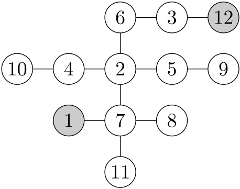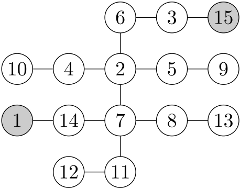
Zadanie Multidrink (mul)
Pomóż nam usprawnić bazę zadań!
Number of users: 123
Number of users with 100 points: 82
Average result: 77.5691
Multidrink
Memory limit: 256 MB
Byteasar lives in Byteburg, a city famous for its milk bars on every corner. One day Byteasar came up with an idea of a "milk multidrink": he wants to visit each milk bar for a drink exactly once. Ideally, Byteasar would like to come up with a route such that the next bar is always no further than two blocks (precisely: intersections) away from the previous one.
The intersections in Byteburg are numbered from  to
to  ,
and all the streets are bidirectional.
Between each pair of intersections there is a unique direct route, ie, one
that does not visit any intersection twice.
Byteasar begins at the intersection no.
,
and all the streets are bidirectional.
Between each pair of intersections there is a unique direct route, ie, one
that does not visit any intersection twice.
Byteasar begins at the intersection no.  and finishes at the intersection
no.
and finishes at the intersection
no.  .
.
Your task is to find any route that satisfies Byteasar's requirements if such a route exists.

An exemplary route satisfying the requirements is: 

There is no route that satisfies the requirements.
Input
In the first line of the standard input there is a single integer  (
( ), denoting the number of intersections in Byteburg.
Each of the following
), denoting the number of intersections in Byteburg.
Each of the following  lines holds a pair of distinct integers
lines holds a pair of distinct integers  and
and  (
( ), separated by a single space, that
represent the street linking the intersections no.
), separated by a single space, that
represent the street linking the intersections no.  and
and  .
.
In tests worth  of all points the condition
of all points the condition  holds.
holds.
Output
If there is no route satisfying Byteasar's requirements, your program
should print a single word "BRAK" (Polish for none),
without the quotation marks to the standard output. Otherwise, your program
should print  lines to the standard output, the
lines to the standard output, the  -th of which should
contain the number of the
-th of which should
contain the number of the  -th intersection on an arbitrary route
satisfying Byteasar's requirements. Obviously, in that case the first line
should hold the number
-th intersection on an arbitrary route
satisfying Byteasar's requirements. Obviously, in that case the first line
should hold the number  , and the
, and the  -th line - number
-th line - number  .
.
Example
For the input data:
12 1 7 7 8 7 11 7 2 2 4 4 10 2 5 5 9 2 6 3 6 3 12
the correct result is:
1 11 8 7 4 10 2 9 5 6 3 12
For the input data:
15 1 14 14 7 7 8 7 11 7 2 2 4 4 10 2 5 5 9 2 6 3 6 3 15 11 12 8 13
the correct result is:
BRAK
Task authors: Jakub Radoszewski, Wojciech Rytter.
<Submit a solution> [0/100]Kontakt
In the event of technical difficulties with Szkopuł, please contact us via email at [email protected].
If you would like to talk about tasks, solutions or technical problems, please visit our Discord servers. They are moderated by the community, but members of the support team are also active there.

 English
English